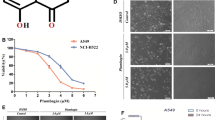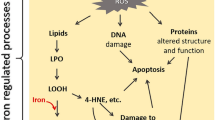Abstract
Objective
To investigate the synergistic effects of carnosic acid (CA) with arsenic trioxide (As2O3) on proliferation and apoptosis in HL-60 human myeloid leukemia cells, and the major cellular signaling pathway involved in these effects.
Methods
HL-60 cellular proliferation was measured by 3-(4,5-dimethylthiazol-2-yl)-2,5-diphenyltetrazolium bromide (MTT) analysis. Cell cycle distribution and apoptosis were monitored by flow cytometry. The activation of casepase-9, Bcl-2-associated agonist of cell death (BAD), p-BAD, p27, phosphatase and tensin homolog deleted on chromosome ten (PTEN), Akt, p-Akt was assessed by Western blot analysis. The expression of PTEN mRNA was tested by reverse transcription polymerase chain reaction (RT-PCR) analysis.
Results
CA reduced HL-60 cell viability in a dose- and time-dependent manner, and induced G1 arrest and apoptosis. Moreover, CA upregulated PTEN expression, blocked the Akt signaling pathway, subsequently inhibited phosphorylation of BAD, reactivated caspase-9, and elevated levels of p27. CA also augmented these effects of As2O3.
Conclusion
CA might be a novel candidate of the combination therapy for leukemia treatment; these effects were apparently associated with the modulation of PTEN/Akt signaling pathway.
Similar content being viewed by others
References
Testa U, Riccioni R. Deregulation of apoptosis in acute myeloid leukemia. Haematologica 2007;92:81–94.
Aruoma OI, Halliwell B, Aeschbach R, Loligers J. Antioxidant and pro-oxidant properties of active rosemary constituents: carnosol and carnosic acid. Xenobiotica 1992;22:257–268.
Fiander H, Schneider H. Dietary ortho phenols that induce glutathione S-transferase and increase the resistance of cells to hydrogen peroxide are potential cancer chemopreventives that act by two mechanisms: the alleviation of oxidative stress and the detoxication of mutagenic xenobiotics. Cancer Lett 2000;156:117–124.
Manoharan S, Balakrishnan S, Vinothkumar V, Silvan S. Anti-clastogenic potential of carnosic acid against 7,12-dimethylbenz(a)anthracene (DMBA)-induced clastogenesis. Pharmacol Rep 2010;62:1170–1177.
Kosaka K, Yokoi T. Carnosic acid, a component of rosemary (Rosmarinus officinalis L.), promotes synthesis of nerve growth factor in T98G human glioblastoma cells. Biol Pharm Bull 2003;26:1620–1622.
Cheng AC, Lee MF, Tsai ML, Lai CS, Lee JH, Ho CT, et al. Rosmanol potently induces apoptosis through both the mitochondrial apoptotic pathway and death receptor pathway in human colon adenocarcinoma COLO 205 cells. Food Chem Toxicol 2011;49:485–493.
Shabtay A, Sharabani H, Barvish Z, Kafka M, Amichay D, Levy J, et al. Synergistic antileukemic activity of carnosic acid-rich rosemary extract and the 19-nor Gemini vitamin D analogue in a mouse model of systemic acute myeloid leukemia. Oncology 2008;75:203–214.
Cerutti PA. Prooxidant states and tumor promotion. Science 1985;227:375–381.
Wang Q, Harrison JS, Uskokovic M, Kutner A, Studzinski GP. Translational study of vitamin D differentiation therapy of myeloid leukemia: effects of the combination with a p38 MAPK inhibitor and an antioxidant. Leukemia 2005;19:1812–1827.
Singh RP, Dhanakakshmi S, Agarwal R. Phytochemicals as cell cycle modulators: a less toxic approach in halting human cancer. Cell Cycle 2002;1:156–161.
Yang E, Zha J, Jockel J, Boise LH, Thompson CB, Korsmeyer SJ. Bad, a heterodimeric partner for Bcl-XL and Bcl-2, displaces Bax and promotes cell death. Cell 1995;80:285–291.
McGowan CH. Regulation of the eukaryotic cell cycle. Prog Cell Cycle Res 2003;5:1–4.
Cantley LC, Neel BG. New insights into tumor suppression: PTEN suppresses tumor formation by restraining the phosphoinositide 3-kinase/AKT pathway. Proc Natl Acad Sci U S A 1999;96:4240–4245.
Di Cristofano A, Pandolfi PP. The multiple roles of PTEN in tumor suppression. Cell 2000;100:387–390.
Chang HW, Aoki M, Fruman D, Auger K R, Bellacosa A, Tsichlis PN, et al. Transformation of chicken cells by the gene encoding the catalytic subunit of PI 3-kinase. Science 1997;276:1848–1850.
Bellacosa A, Testa JR, Staal SP, Tsichlis PN. A retroviral oncogene, akt, encoding a serine-threonine kinase containing an SH2-like region. Science 1991;254:274–277.
Datta SR, Dudek H, Tao X, Master S, Fu H, Gotoh Y, et al. Akt phosphorylation of BAD couples survival signals to the cell-intrinsic death machinery. Cell 1997;91:231–241.
Cardone MH, Roy N, Stennicke HR, Salvesen GS, Franke TF, Stanbridge E, et al. Regulation of cell death protease caspase-9 by phosphorylation. Science 1998;282:1318–1321.
Ramaswamy S, Nakamura N, Vazquez F, Batt DB, Perera S, Roberts TM, et al. Regulation of G1 progression by the PTEN tumor suppressor protein is linked to inhibition of the phosphatidylinositol 3-kinase/Akt pathway. Proc Natl Acad Sci U S A 1999;96:2110–2115.
Vivanco I, Sawyers CL. The phosphatidylinositol 3-kinase/AKT pathway in human cancer. Nat Rev Cancer 2002;2:489–501.
Dahia PL, Aguiar RC, Alberta J, Kum JB, Caron S, Sill H, et al. PTEN is inversely correlated with the cell survival factor Akt/PKB and is inactivated via multiple mechanisms in haematological malignancies. Hum Mol Genet 1999;8:185–193.
Goering PL, Aposhian HV, Mass MJ, Cebrian M, Beck BD, Waalkes MP. The enigma of arsenic carcinogenesis: role of metabolism. Toxicol Sci 1999;49:5–14.
Soignet SL, Maslak P, Wang ZG, Thanwar S, Calleja E, Dardashti LJ, et al. Complete remission after treatment of acute promyelocytic leukemia with arsenic trioxide. N Engl J Med 1998;339:1341–1348.
Niu C, Yan H, Yu T, Sun HP, Liu JX, Li XS, et al. Studies on treatment of acute promyelocytic leukemia with arsenic trioxide: remission induction, follow-up, and molecular monitoring in 11 newly diagnosed and 47 relapsed promyelocytic leukemia patients. Blood 1999;94:3315–3324.
Jing Y, Wang R, Xia L, Chen GQ, Chen Z, Miller WH, et al. Combined effect of all-trans retinoic acid and arsenic trioxide in acute promyelocytic leukemia cells in vitro and in vivo. Blood 2001;97:264–269.
Miller WH Jr, Schipper HM, Lee JS, Singer J, Waxman S. Mechanisms of action of arsenic trioxide. Cancer Res 2002;62:3893–3903.
Lallemand-Breitenbach V, Guillemin MC, Janin A, Daniel MT, Degos L, Kogan SC, et al. Retinoic acid and arsenic synergize to eradicate leukemic cells in a mouse model of acute promyelocytic leukemia. J Exp Med 1999;189:1043–1052.
Danilenko M, Wang X, Studzinski GP. Carnosic acid and promotion of monocytic differentiation of HL60-G cells initiated by other agents. J Natl Cancer Inst 2001;93: 1224–1233.
Author information
Authors and Affiliations
Corresponding author
Additional information
Supported by the National Natural Science Foundation of China (No. 81102710)
Rights and permissions
About this article
Cite this article
Wang, R., Cong, Wh., Guo, G. et al. Synergism between carnosic acid and arsenic trioxide on induction of acute myeloid leukemia cell apoptosis is associated with modulation of PTEN/Akt signaling pathway. Chin. J. Integr. Med. 18, 934–941 (2012). https://doi.org/10.1007/s11655-012-1297-z
Received:
Published:
Issue Date:
DOI: https://doi.org/10.1007/s11655-012-1297-z




